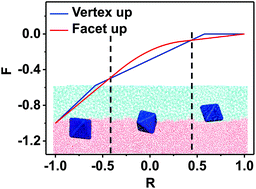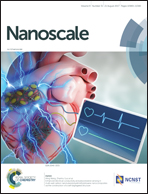Quantitative prediction of the position and orientation for an octahedral nanoparticle at liquid/liquid interfaces†
Abstract
Shape-controlled polyhedral particles and their assembled structures have important applications in plasmonics and biosensing, but the interfacial configurations that will critically determine their resultant assembled structures are not well-understood. Hence, a reliable theory is desirable to predict the position and orientation of a polyhedron at the vicinity of a liquid/liquid interface. Here we demonstrate that the free energy change theory can quantitatively predict the position and orientation of an isolated octahedral nanoparticle at a liquid/liquid interface, whose vertices and facets can play crucial roles in biosensing. We focus on two limiting orientations of an octahedral nanoparticle, vertex up and facet up. Our proposed theory indicates that the surface wettability (hydrophilic/hydrophobic ratio) of the nanoparticle determines its most stable position and the preferred orientation at a water/oil interface. The surface wettability of an octahedron is adjusted from extremely hydrophobic to extremely hydrophilic by changing the amount of charge on the Ag surface in molecular dynamics (MD) simulations. The MD simulations results are in excellent agreement with our theoretical prediction for an Ag octahedral nanoparticle at a hexane/water interface. Our proposed theory bridges the gap between molecular-level simulations and equilibrium configurations of polyhedral nanoparticles in experiments, where insights from nanoparticle intrinsic wettability details can be used to predict macroscopic superlattice formation experimentally. This work advances our ability to precisely predict the final structures of the polyhedral nanoparticle assemblies at a liquid/liquid interface.



 Please wait while we load your content...
Please wait while we load your content...